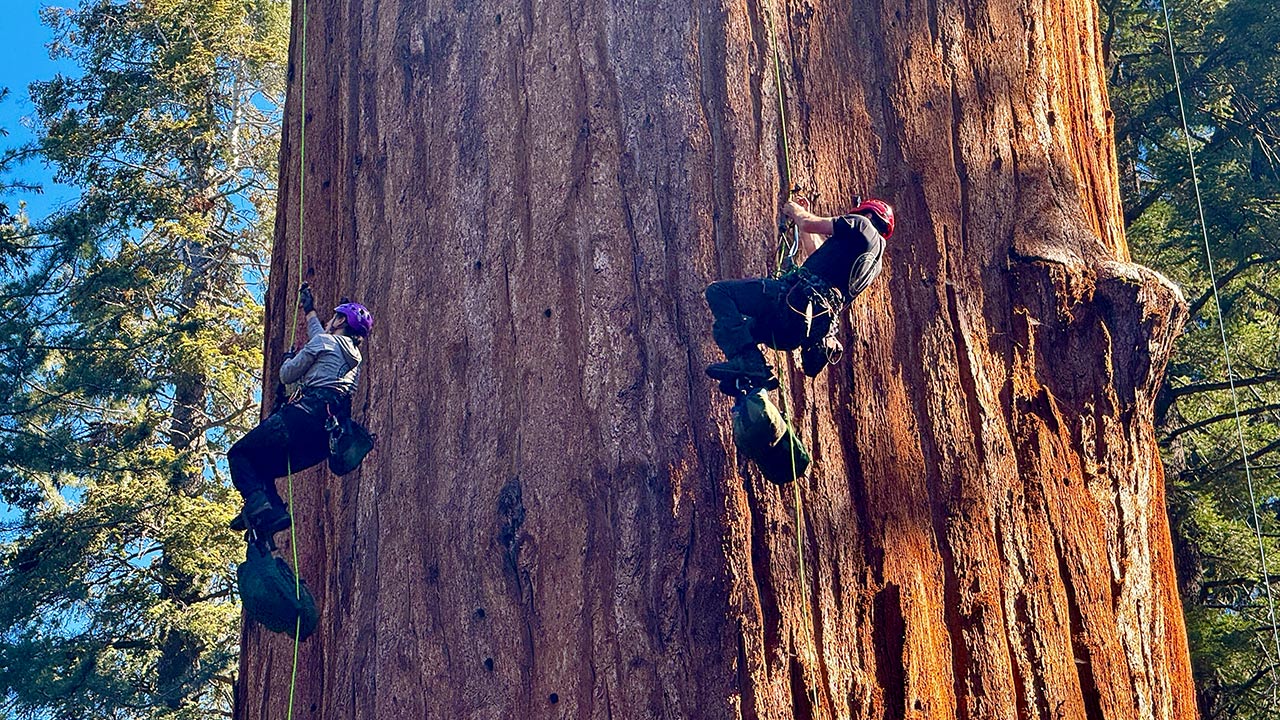Researchers scaling General Sherman in Sequoia National Park find the iconic tree healthy, but climate change and bark beetles pose rising threats. (AP/Terry Chea)

- Researchers conducted a health check on General Sherman, the world's largest tree.
- The tree was found to be in good health and able to fend off bark beetle attacks.
- Researchers have discovered that bark beetles can kill sequoias, climate change also poses a threat.
Share
|
Getting your Trinity Audio player ready...
|
SEQUOIA NATIONAL PARK — High in the evergreen canopy of General Sherman, the world’s largest tree, researchers searched for evidence of an emerging threat to giant sequoias: bark beetles.
They descended the towering 2,200-year-old tree with good news on Tuesday.
“The General Sherman tree is doing fine right now,” said Anthony Ambrose, executive director of the Ancient Forest Society, who led the climbing expedition. “It seems to be a very healthy tree that’s able to fend off any beetle attack.”
It was the first time that climbers had scaled the iconic 275-foot (85-meter) sequoia tree, which draws tourists from around the world to Sequoia National Park.
Probably the first climb ever of the General Sherman Tree, the world’s largest tree.
Researchers with the @AFSociety ascended the 275-foot giant sequoia this week to look for bark beetles, the latest threat to sequoia trees: https://t.co/PwKeMEgXH9 Video from @NatlParkService pic.twitter.com/K1GocWAwPZ
— Kurtis Alexander (@kurtisalexander) May 22, 2024
Threats to Giant Sequoias
Giant sequoias, the Earth’s largest living things, have survived for thousands of years in California’s western Sierra Nevada mountain range, the only place where the species is native.
But as the climate grows hotter and drier, giant sequoias previously thought to be almost indestructible are increasingly threatened by extreme heat, drought and wildfires.
In 2020 and 2021, record-setting wildfires killed as much as 20 percent of the world’s 75,000 mature sequoias, according to park officials.
“The most significant threat to giant sequoias is climate-driven wildfires,” said Ben Blom, director of stewardship and restoration at Save the Redwoods League. “But we certainly don’t want to be caught by surprise by a new threat, which is why we’re studying these beetles now.”
Related Story: Anonymous Gifts Are Common. But a Climate Group Says a $10 Million Gift It Got ...
Bark Beetles: A New Threat
But researchers are growing more worried about bark beetles, which didn’t pose a serious threat in the past.
The beetles are native to California and have co-existed with sequoias for thousands of years. But only recently have they been able to kill the trees. Scientists say they recently discovered about 40 sequoia trees that have died from beetle infestations, mostly within the national parks.
“We’re documenting some trees that are actually dying from kind of a combination of drought and fire that have weakened them to a point where they’re not able to defend themselves from the beetle attack,” Ambrose said.
The beetles attack the trees from the canopy, boring into branches and working their way down the trunk. If left unchecked, the tiny beetles can kill a tree within six months.
That’s why park officials allowed Ambrose and his colleagues to climb General Sherman. They conducted the tree health inspection as journalists and visitors watched them pull themselves up ropes dangling from the canopy. They examined the branches and trunk, looking for the tiny holes that indicate beetle activity.
But it’s not possible to climb every sequoia tree to directly inspect the canopy in person. That’s why they’re also testing whether drones equipped with sensors and aided by satellite imagery can be used to monitor and detect beetle infestations on a larger scale within the forests.
Related Story: Scores of Starving and Sick Pelicans Found Along the California Coast
Future Plans for Giant Sequoia Protection
Tuesday’s health inspection of General Sherman was organized by the Giant Sequoia Lands Coalition, a group of government agencies, Native tribes and environmental groups. They hope to establish a health monitoring program for the towering trees.
If they discover beetle infestations, officials say, they could try to combat the attacks by spraying water, removing branches or using chemical treatments.
Bark beetles have ravaged pine and fir forests throughout the Western United States in recent years, but they previously didn’t pose a threat to giant sequoias, which can live 3,000 years.
“They have really withstood insect attacks for a lot of years. So why now? Why are we seeing this change?” said Clay Jordan, superintendent for Sequoia and Kings Canyon National Parks. “There’s a lot that we need to learn in order to ensure good stewardship of these trees for a long time.”
RELATED TOPICS:
Categories




















